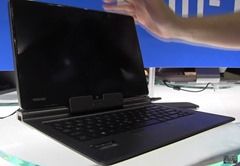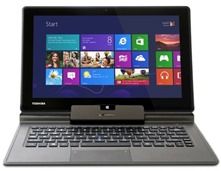This looks like it could be a problem for those Ultrabook convertibles or 2-in-1 Ultrabooks that were launching with Ivy Bridge Y-Series processors. Haswell Y-Series refreshes will blow them away with battery life so why would you buy the ‘old’ version now? The Toshiba Z10T is one of the dockables that could suffer unless pricing is adjusted quickly. The Lenovo 11S (that I think we saw on stage in a Haswell demo today) is another. Moblegeeks have a video below but before that, there’s a little surprise on the GPU information we’ve obtained.
Mobilegeeks took a look at the Toshiba Z10T and although they didn’t mention it, I spotted the Core 4200Y @ 1.4Ghz on screen thanks to 1080p.
Intel Core (TM) 4200Y CPU @ 1.40 Ghz 1.40Ghz
This is a Core i5 CPU at 11.5W TDP and 6W SDP (source: Intel. So now we know exactly what 6W SDP means.) Max clock is 1.9Ghz so don’t expect Ultrabook laptop performance where a Core i5 4200U runs from 1.6Ghz up to 2.6Ghz. GPU clock is also capped on this processor and there’s a surprise here. The GPU is only an HD4200 which we think means it only has the ‘single slice’ GT2 graphics, a configuration that won’t give you much advantage over previous generation GPUs. We’re looking further into this for you. GT3 graphics, the dual-slice GPU (in effect, dual-core) appears on HD5000 and HD5100 (Iris Graphics with the 28W TDP high-end processors)
While we look further into the GPU information, take a look around the Toshiba Z10T. It’s not the most attractive dockable but neither was the Fujitsu Q702 but we got some serious work done on it. (Fujitsu Q702 Review here)
Thanks Mobilegeeks.













Was hopping the 10 in the name meant a 10″ screen.
The GT2 based HD 4200 and HD 4400 won’t be that much slower, because HD 5000 despite the same top Turbo frequency will have lot less practical frequency. That’s how they achieve more performance at the same TDP.
But they are single slice GPUs David.
I’ve just published some more info here.
http://ultrabooknews.com/2013/06/05/14-intel-4th-gen-core-u-and-y-series-processors-listed-tops-out-at-3-3ghz-with-gpu-surprises/
Comments welcome, as always.
Chippy.
Anandtech’s preliminary results are talking about only 15-25% gain for the HD 5000. There will be cases that will be larger, but the average is around there. Because they have same clocks, that means the HD 5000 uses the GT3 SKU for top perf/watt, rather than peak perf compared to the HD 4400.
You are probably talking about 600-700MHz practical frequency on the HD 5000 vs the Ivy Bridge generation which could do ~1GHz in games. That keeps the gains a lot less despite the doubled slice.
The high end Iris 5100 with the 28W chips are showing 60-80% in gaming, but that’s totally different.